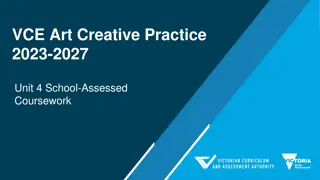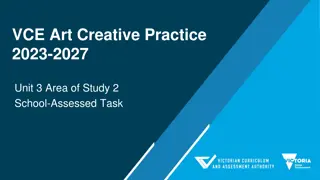VCE Art Making and Exhibiting: Conservation and Care of Artworks
Explore the importance of conservation and care in presenting artworks, focusing on exhibition spaces, art forms, and the role of research in preserving art. Delve into exhibition design, curation, and conservation practices to understand how to maintain and showcase artworks effectively.
Download Presentation

Please find below an Image/Link to download the presentation.
The content on the website is provided AS IS for your information and personal use only. It may not be sold, licensed, or shared on other websites without obtaining consent from the author.If you encounter any issues during the download, it is possible that the publisher has removed the file from their server.
You are allowed to download the files provided on this website for personal or commercial use, subject to the condition that they are used lawfully. All files are the property of their respective owners.
The content on the website is provided AS IS for your information and personal use only. It may not be sold, licensed, or shared on other websites without obtaining consent from the author.
E N D
Presentation Transcript
VCE Art Making and Exhibiting 2023-2027 Unit 4 Area of Study 3
VCE Art Making and Exhibiting Unit 4 Area of Study 3 Outline Features of Art Making and Exhibiting Unit 4 Outcome 3 overview Teaching ideas Assessment ideas
VCE Art Making and Exhibiting Study specifications Explore Expand Investigate Understand Develop Resolve Collect Extend Connect Consolidate Present Conserve
VCE Art Making and Exhibiting Study specifications: Exhibiting artworks Planning and producing the layout and design of the exhibition and planning the flow of the exhibition, including sight lines, spatial relationships, viewer interaction and interpretation. Includes the creation of display furniture, selection of fixtures and use of lighting. Exhibition design Determining the theme or story to be told in an exhibition. Curation includes the selection of artworks, writing the introduction to the exhibition, deciding where artworks will be placed, the designing of viewer interaction and interpretation, and the preparation of condition reports of artworks. Curation Planning, organising and undertaking the preservation and conservation of materials and objects in private, public and community collections, including art galleries, museums, other exhibition spaces and site-specific spaces. Conservation
VCE Art Making and Exhibiting Study specifications: Exhibiting artworks Explore Expand Investigate Understand Develop Resolve Collect Extend Connect Consolidate Present Conserve Museums Exhibition design Galleries Curation Other exhibition spaces Conservation Site specific spaces
VCE Art Making and Exhibiting Study specifications: Study Terms Art elements Art principles Art forms Contexts Critique Influences and inspiration Visual language Aesthetic qualities
VCE Art Making and Exhibiting Unit 4 Area of Study 3: Conserve present and care On completion of this unit the student should understand the presentation, conservation and care of artworks, including the conservation and care of their own artworks. What role does conservation and care have in the presentation of artworks? What exhibition spaces will I focus on? What artforms will I focus on? What will I learn from my research that will help me conserve and care for my own artworks? What are the conservation and care methods applied to artworks on display? What are the conservation and care methods applied to artworks on display? Outcome 3 Learning structure
VCE Art Making and Exhibiting Unit 4 Area of Study 3: Conserve present and care methods used and considerations involved in the presentation, conservation and care of artworks while on display in an exhibition space considerations of conservation and care that relate to artworks in the handling, storage and transportation of artworks relevant conservation and care methods that students can apply to their own artworks when on display relevant conservation and care methods that students can apply to their own artworks in storage, handling and transportation terminology used to discuss the conservation and care of artworks Key knowledge
VCE Art Making and Exhibiting Unit 4 Area of Study 3: Conserve present and care investigate, identify and evaluate the methods used and considerations involved in the presentation, conservation and care of artworks while on display in an exhibition space investigate, identify and evaluate conservation and care in the handling, storage and transportation of artworks discuss the relevant conservation and care methods that can apply to their own artworks when on display compared to artworks studied in exhibitions visited in the current year of study discuss the relevant conservation and care methods that can apply to their own artworks in storage, handling and transportation compared to artworks studied in exhibitions visited in the current year of study apply terminology in the discussion of the conservation and care of artworks Key skills
VCE Art Making and Exhibiting Unit 4 Area of Study 3 Teaching and Learning Ideas Plan and participate in on-site excursions or virtual visits to at least two art exhibitions and/or art collections storage facilities Access the chosen exhibition and/or collection storage facilities via guided tours with art industry education staff and/or personnel involved in curating, collection management and installation of artworks. Research best practice methods and museum standards for the care and conservation of artwork while on display and in storage. View online videos and resources about conservation and care of artworks such as Conservation at MuMA https://www.monash.edu/muma/education/educational-resources Collate relevant information. About how specific examples of artworks and art forms are cared for and conserved in the Visual Arts Journal Apply knowledge about care and conservation of artworks to a case study of a selected artwork viewed during the current year of study as well as their own artwork in a SAC task.
VCE Art Making and Exhibiting Unit 4 Area of Study 3 Teaching and Learning Ideas Exhibition Making Explore a range of exhibition types and spaces. For example: survey, retrospective, group, thematic, solo, Biennale, Triennale. Ask students questions such as: What is an exhibition? What is the purpose of an exhibition? What is the difference between a display, exhibition and show? How can colour influence the way artworks are viewed? Museum Floorplan and Flow - types of floor plans Make a model of the exhibition space and place small scale replicas of your artworks in the space. Labels and Wall Text How to write interpretive labels for the artworks and the information text on the walls. Choose a series of artworks and practice writing interpretive labels. They should be no longer than 50 words.
Teaching and Learning Ideas Exhibition Making Collateral Material Explain the common forms of collateral materials such as handouts, website, audio tours, catalogue, room sheets, apps Building an exhibition Discuss some of the considerations when presenting artworks such as hanging systems and eye levels, exhibition cases (vitrines), barriers, mannequins, objects display mounting, lighting, wall colour.
VCE Art Making and Exhibiting Unit 4 Area of Study 3 Detailed learning example A CASE STUDY: CONSERVATION AND CARE OF ARTWORKS Select at least two exhibitions and/or collections to visit at galleries, museums, collections, online galleries, other exhibition spaces and/or site-specific spaces. Before visits to the exhibition/collection spaces Make contact with venues beforehand Discuss outcomes, key knowledge and key skills with gallery staff and students. Devise a series of structured questions in the form of a matrix/handout addressing each key knowledge and key skill of Unit 4, Outcome 3. Be aware of etiquette and appropriate behaviour in a gallery space/collection facility
VCE Art Making and Exhibiting Unit 4 Area of Study 3 Detailed learning example A CASE STUDY: CONSERVATION AND CARE OF ARTWORKS During the exhibition/collection visits Encourage students to document and collect relevant information about the presentation, care and conservation of specific art forms including examples of: Exhibition furniture and invigilation practices Art handling, transport, condition reporting and storage Principles of material stability for different art forms How lighting levels, temperature and humidity can affect the condition of artworks on display and in storage. Ethical and cultural considerations and protocols for the display, storage and handling of specific artworks, including works by First Nations Australian artists. Balancing the intentions of artists with the conservation of artworks and access for. Audiences A glossary of relevant terms in relation to the care, conservation and presentation of artworks.
VCE Art Making and Exhibiting Unit 4 Area of Study 3 Detailed learning example A CASE STUDY: CONSERVATION AND CARE OF ARTWORKS After the exhibition visits Discuss and reflect on the visits and guide students to summarise and consolidate their understandings of the presentation, conservation and care of artworks. Encourage students to apply their knowledge of presentation, conservation and care of artworks to one of their own artworks.
VCE Art Making and Exhibiting Unit 4 Area of Study 3 Assessment Students present a case study, with written and visual material, outlining the conservation and care of: The case study can be presented using any of the following formats: annotated visual report annotated poster or display publication in hard copy or online presentation in a digital format, such as an online presentation or interactive website oral presentation with written and visual imagery evidence. a selected artwork viewed in an exhibition in the current year of study the conservation methods used for the display of their own artworks.
VCE Art Making and Exhibiting Unit 4 Area of Study 3 Assessment Example School Assessed Coursework Task: Plan a thematic, group exhibition Students develop a case study with written and visual material outlining the conservation and care of: A selected artwork they have viewed during a visit to an exhibition/collection AND the conservation and care of one of their own artworks Conservation and care for their own artworks Prepare a condition report to plan and document the display for at least one finished artwork form Unit 4. A condition report includes information such as the name of the artist, title of artwork, medium, dimensions, orientation of the artwork, date of writing the condition report, short description of artist s intention, preferred display conditions, description of how the artwork should be packaged for transport an/or storage, instructions for assembling the work, photographs/images of the work, file type for digital artworks. Present the condition report in the Visual Arts Journal and refer to it during the critique
Contact Dr Kathryn Hendy-Ekers Curriculum Manager Visual Arts, Visual Communication Design and Media E: Kathryn.Hendy-Ekers@education.vic.gov.au T: 9059 5147 M: 0438471513























